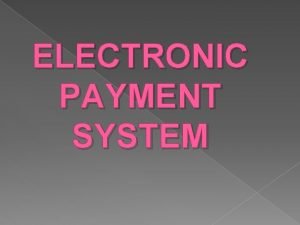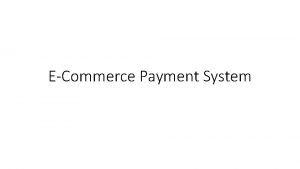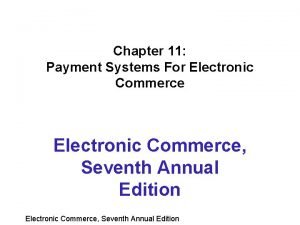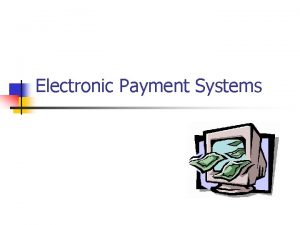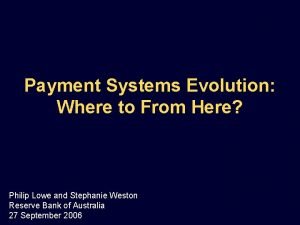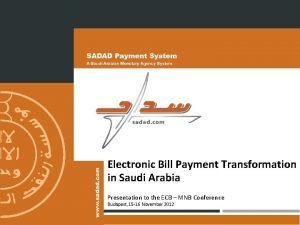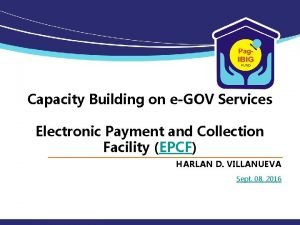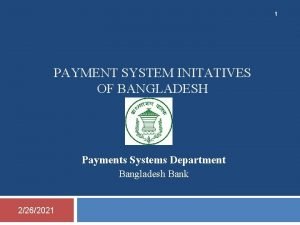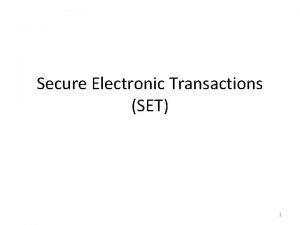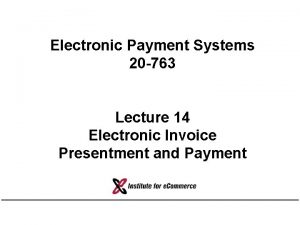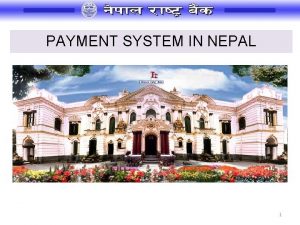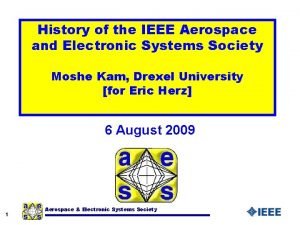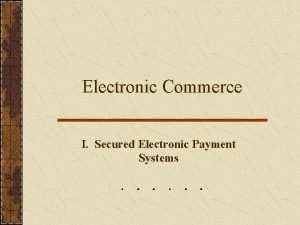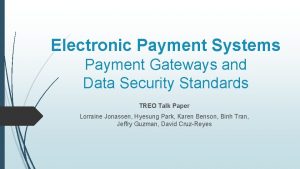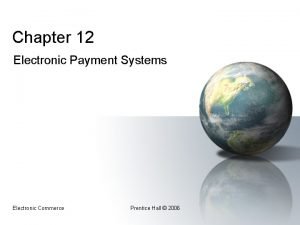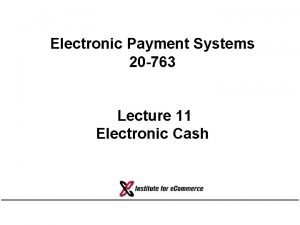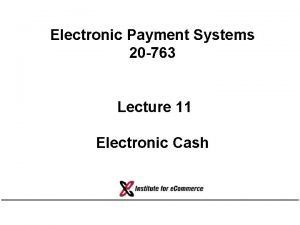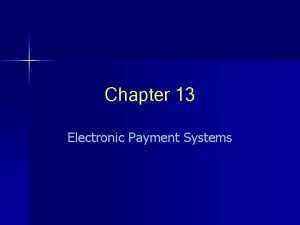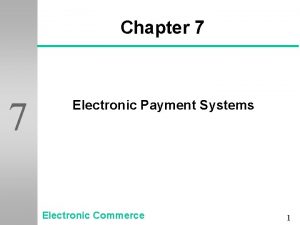Payment Systems 1 Electronic Payment Schemes Schemes for
















- Slides: 16

Payment Systems 1

Electronic Payment Schemes • Schemes for electronic payment are multi-party protocols • Payment instrument modeled by electronic coin that has a fixed value and can be exchanged with a traditional monetary instrument • Parties include: Customer Merchant – Payer (customer) – Payee (merchant) – Bank 2

Transactions • Transactions in an electronic payment scheme typically include: Customer Merchant pay sit po de $ aw dr th wi – Withdrawal of coins by customer from the bank – Payment of coins by customer to merchant – Deposit of coins by merchant into bank $ $ • Online scheme: – The bank participates in the payment transaction • Offline scheme – The bank does not participate in the payment transaction 3

Goals • Integrity – Coins cannot be forged – Legitimate transactions are honored • Accountability – Transactions cannot be later denied – Disputes can be efficiently settled • Privacy – The identity of some parties is not revealed to other parties – Coins cannot be traced to the payer and/or payee (digital cash) 4

Payment with Digital Signatures • Coins are random identifiers digitally signed by the bank at the time of withdrawal • The merchant verifies the signature by the bank • The bank honors deposit of valid coins • Security and privacy issues: – Customer can copy coin and double spend – The bank learns about every transaction by customer and merchant $ Customer Merchant pay sit po de aw dr th wi $ $ 5

Private Payment Scheme • A blind signature allows the signed to sign a message without knowing the message itself • Basic digital cash scheme: – The bank does a blind signature on the coins withdrawn by the customer – The merchant verifies the signature and deposits the coins – The bank cannot link the coins to the customer 6

Blind Signatures with RSA • The RSA cryptosystem supports a simple and efficient blind signature scheme • Consider an RSA signing scheme with – Public modulus N – Public encryption exponent e and public cryptographic hash function h – Secret decryption exponent d • The bank can create a signature on any item without knowing it • Bank must have assurance that it is signing a valid coin of the correct amount 7

RSA Blind Signature Protocol • The customer picks secret random values x and r – Coin identifier x – Number r in ZN relatively prime to N • The customer sends to the bank value y = re h(x) mod N • The bank creates signature s(y) on y s(y) = yd mod N • The customer derives from s(y) signature s(x) on x s(x) = s(y) / r mod N • Proof s(y) / r mod N = red - 1 h(x)d mod N = s(x) 8

Blindly Signing a Valid Coin • The customer generates k coins and submits to the bank commitments (cryptographic hashes) for all the coins • The bank randomly selects k - 1 coins • The customer reveals to the bank the selected k - 1 coins • The bank verifies the commitments on the selected k - 1 coins • The bank creates a blind signature on the remaining coin • The coin signed by the bank is valid with probability 1 - 1/ k 9

Defenses Against Double Spending • Online protocol – The bank is online during the payment transaction to revoke spent coins • Offline protocol – Withdrawn coins embed encrypted customer identity – Deposited coins embed also encrypted merchant identity – Double spending caused the identity of the cheating party to be revealed 10

Secret Splitting into Shares • A secret string x can be split into random values y and z as follows – Pick a random value y – Set z = y x • String x can be reconstructed from y and z by setting – x=y z • Both shares y and z are random values and are referred to as shares of x • Neither share reveals any information about secret x 11

Coins • Let h be a cryptographic hash function • Given a secret string x, a commitment pair for x is a pair (a, b) such that – a = h(y) – b = h(z) – y and z are random shares of x • Let ID be a string identifying the customer (e. g. , name, address, etc. ) • The coin issued by the bank to the customer consists of – Coin identifier x – Vector of n commitments pairs (a 1, b 1), … , (an, bn) for ID • The coin does not reveal the identity of the customer 12

Withdrawal • The customer generates and submits k coins to the bank • The bank randomly selects k - 1 coins • The customer reveals to the bank the shares associated with the commitments pairs of the selected coins • The bank creates a blind signature on the remaining coin • The coin signed is valid with probability 1 - 1/ k 13

Payment • The customer gives to the merchant a coin { x ; [(a 1, b 1), … , (an, bn)] } • The merchant verifies the signature on the coin • The customer gives to the customer a random binary vector s 1, … , sn, called selector • The customer reveals to the merchant the shares indicated by the selector, i. e. , it sends to the merchant a vector of strings P 1, … , Pn such that h(Pi) = ai if si = 0 h(Pi) = bi if si = 1 14

Deposit and Security Properties • Deposit – The merchant deposits with the bank the coin and strings P 1, … , Pn – The bank verifies the signature and keeps track of coins and associated strings • Security properties – The probability that the selectors provided by two merchants are identical is 1/ 2 n – Thus, if the customer double spends a coin, then the bank finds out the identity of the customer with probability 1 - 1/ 2 n – A merchant can double spends a coin without being detected by the bank only if it can find a collision of the hash function • The scheme does not prevent double spending but detects it and identifies the culprit with high probability 15

References • The electronic cash scheme presented in this lecture is based on the work by David Chaum http: //www. chaum. com/ • D. Chaum, A. Fiat, and M. Naor. Untraceable Electronic Cash, in Proc. CRYPTO 1988. http: //citeseer. ist. psu. edu/421212. html • S. Goldwasser and M. Bellare. Lecture Notes on Cryptography [Section 12. 5] http: //www-cse. ucsd. edu/users/mihir/papers/gb. html 16
 Full form of eps in commerce
Full form of eps in commerce Electronic payment systems for ecommerce
Electronic payment systems for ecommerce Payment systems for electronic commerce
Payment systems for electronic commerce Scrip exchange
Scrip exchange Electronic news gathering and electronic field production
Electronic news gathering and electronic field production Objectives of electronic payment system
Objectives of electronic payment system Paytrust bill center
Paytrust bill center Evolution of electronic payment system
Evolution of electronic payment system Secure electronic transaction advantages disadvantages
Secure electronic transaction advantages disadvantages Electronic bill presentation and payment
Electronic bill presentation and payment Epcf enrollment form lbp
Epcf enrollment form lbp What is npsb
What is npsb Secure electronic transaction
Secure electronic transaction Future of electronic payment system
Future of electronic payment system Nepal electronic payment system
Nepal electronic payment system Principles of electronic communication systems 3rd edition
Principles of electronic communication systems 3rd edition Aerospace and electronic systems society
Aerospace and electronic systems society
